Processing Methods for Dry Peas, Lentils & Chickpeas
Legumes go through several processes before they are ready to be used either as a plated item or as an ingredient in food preparations. These processes can include cleaning, drying, sorting, splitting, milling, and fractionating. Depending on the pulse and its intended use, other steps like de-hulling (decorticating), puffing, roasting, and grinding may be included as well.
Once the field-dried pulse product is received at the processing facility it is visually inspected for color and general quality and then loaded into storage bins. Storage of the newly received product is key to quality and optimum preservation of the crop.
Each crop requires slightly different storage conditions, so humidity and temperature are controlled to maintain the best conditions for preservation and to eliminate the possibility of pest or fungal infestation.
As the product is dropped from the receiving bins for initial air cleaning, magnets are used to attract and remove any metal debris or stones from the product. In addition, many processors conduct a second and final screening with rare earth magnets to ensure removal of metal before after the product has been bagged.
After completion of processing, the product is bagged and shipped to the customer. Quality checks vary from one processor to another, including inspection and packaging methods used before shipment.
Pulses may be packed and shipped after cleaning or might go under further processing. The most common practice is de-hulling and splitting. This takes the seed coat off and makes the pulses easier to digest while improving other qualities.
In most cases, pulses are first soaked in cold water overnight for 4 to 12 hours to improve the de-hulling and splitting process. Hydration can be enhanced by using warm/hot water; this also helps prevent seed hardness. Heating is more costly for processors andshould be carried out in carefully controlled process in order to maximize the yield while preventing unwanted microbial issues. Pulses with thick, tough seed coats are often first abraded and mechanically cracked before soaking to help facilitate moisture uptake. This also promotes faster cooking and more digestible cotyledons.
Asian producers often hold their food legumes at ambient temperatures for several days after soaking. This enables them to germinate, which activates certain enzymes that then partially hydrolyze (i.e., digest) the proteins, starch, and oligosaccharides. It also inactivates tannins, releases minerals, and synthesizes many vitamins. The sprouted grains are then consumed directly or dehulled, roasted, and ground for use in blends and other foods.
Pulses could be consumed either as whole or in the form of ingredients like flour. For producing flour, whole legumes or hulled splits are either ground dry into a flour or ground wet into a batter for other food uses, often in combination with cereal and millet. The properties of the product, such as mouth-feel, texture, and others are impacted by the composition of the pulse, the fineness of the grinding, the ratio of particle size grades, and the cooking conditions.
Cleaning
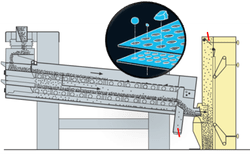
The first step in the processing regimen of a legume is cleaning. The cleaning process usually starts with a screen cleaner and aspirator to take out coarse and fine impurities as well as dust. Screen cleaners are available in different types and sizes but they usually consist of flat sieves with slotted or round holes to separate fine and coarse impurities based on size.
Most pulse processors then use a de-stoner to take out high density impurities such as stones, pieces of metal and glass. In a de-stoner, the product will be spread over a perforated deck. The air passing through the perforated surface will create an air cushion on which the pulses will float slowly towards the machine outlet by gravity. Heavy particles (i.e. stones) will sink to the bottom of the stream and pushed upward by the vibratory action of the deck. Stones will be discharged from the upper side of the machine. Some de-stoners have a stratification step prior to the main deck.

Processors run the pulses over gravity tables, which act as a filter to rid them of light density foreign material like pebbles, dirt and any undeveloped, broken, damaged, or shrunken pieces.
Gravity tables also work on the principle of floating the product over an air cushion and classifying them based on the difference on density
For split peas, initial cleaning and de-stoning is performed after receipt of the dried product, followed by steaming and tempering. These processes prepare the dry peas for a uniform split in the pea splitter and minimize shattering and other product loss issues. Sometimes, steaming and tempering is done just prior to splitting.
Most processors use optical sorters at the end of their cleaning line to take out more challenging defects as well as discolored pulses before packaging.
Sorting
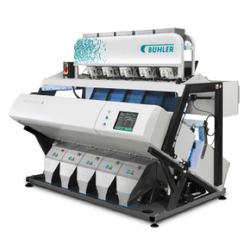
Sorting of pulses could be based on size, density and color amongst other criteria.
Size sorting of pulses could be done on separators. For chickpeas, the separators usually employ five sieves varying in dimension from 6 millimeters to 10 millimeters.
Optical sorters are widely used to ensure uniform color of pulse as well as to improve the cleaning process by removing foreign material and cross contamination.
Gravity tables are typically used to grade pulses based on density (i.e. taking out immature seeds).
The product will then often proceed to a metal detection system prior to a final air-blast cleaning and bagging. Sending products through additional magnets that act as pre-screeners enables processors to help ensure absolute food safety prior to final packaging.
Dehulling or Decortication
The dehulling of legumes generally consists of two steps: 1) loosening the hull (by the dry or wet method), and 2) removing the hull and cleaning. Loosening the hull can be done by a variety of means, including:
- Prolonged sun drying until the hull is loosened
- Applying small quantities of edible oil, followed by sun drying and tempering
- Soaking the legumes in water for several hours, followed by coating them with red-earth slurry and sun drying
- Soaking in water for several hours to loosen the hull before manufacture of food products
- A combination of the above
Dehulling (decortication) produces refined cotyledons with good appearance, texture, and cooking qualities. Legumes that have gone through this process are more easily digested and efficiently utilized by the body.
The process can be a time-consuming procedure depending on how tightly the legume hull wraps around the endosperm (i.e., the nutritive matter in the seed), because of the thin layer of gums and mucilages (i.e., the gummy secretions or gelatinous substances present in plants).
The success with which a legume can be dehulled is influenced by the variety, season when harvested, and location of cultivation. Larger or bold-grain varieties are easier to dehull and give a higher yield, making them the preferred variety among millers. Smaller varieties, mean- while, require repeated pre-dehulling treatments and other complex procedures. Because their hulls are comparatively easy to remove, dry peas, lentils, and chickpeas require less drying and fewer oil or water treatments.
Freshly harvested legumes are more difficult to process, likely because of their higher moisture content. Legumes of this kind are either stored for some period of time to reduce moisture, or are treated with lime water or a solution of sodium carbonate to loosen the hull.
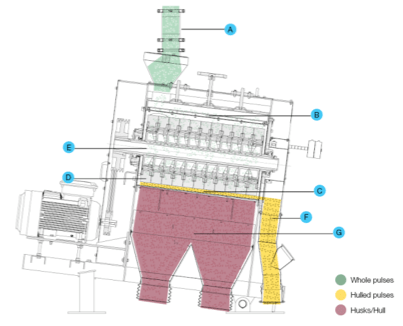
There are a variety of ways to decorticate food legumes. The oldest and most com- mon technique involves spreading out the seeds to dry in the sun or mixing them with a bit of water before pounding them in a mortar with a pestle. The hull is winnowed off to get the clean cotyledons. Similar methods are used in commercial mills, though being much larger in scale they are adapted for greater yield and operational efficiency
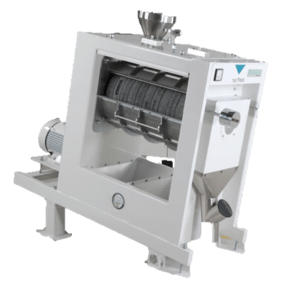
Smaller processors can expect about 50 percent removal with the first effort in traditional de-hulling methods. The process is then repeated several times until almost all the grain is converted into dehulled, split cotyledons. It can be difficult with this approach to achieve complete removal of the hull from the grain. Breakage is also a common downside.
Another method for dehulling is based on adjusting the moisture of the grain to loosen the hull. The grain is first exposed to heated air in a tempering bin, for a pre-determined time based on the variety. Through gradual aeration it reaches a critical moisture level. The hull is then removed in an abrasion-type hulling machine, while efforts are made to minimize scouring or breaking endosperm. If it is to be split, the whole dehulled grain is then ready to proceed to a splitting machine.
Splitting
Many of the operations, particularly decorticating and splitting, are mechanized. Splitting is often carried out in parallel with dehulling, though both are more effective if undertaken as independent operations.
Adding water prior to dehulling helps bring about splitting. Such a step does, however, often leave portions of hull on the split cotyledons (dhal) that then have to be removed by polishing machines. During splitting, the germ, which forms about 2 percent to 5 percent, is typically lost.
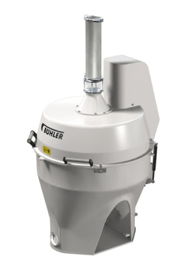
After drawing or winnowing off the hull, the split cotyledons are separated by sieving. Any leftover whole grains that have not been split are similarly processed until as much of the grain as possible is dehulled
